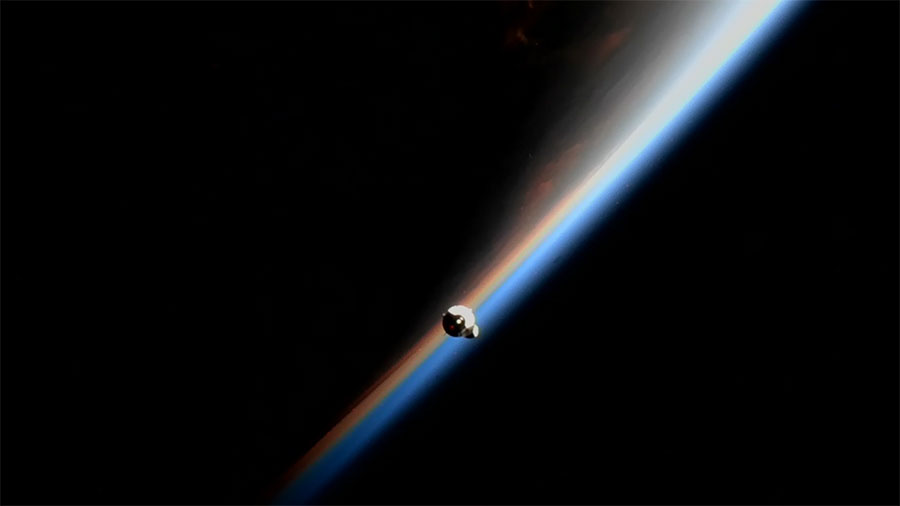
For SpaceUpClose.com & RocketSTEM
KENNEDY SPACE CENTER, FL – A SpaceX Dragon commercial cargo spacecraft docked autonomously to the International Space Station, Saturday morning, July 16, delivering three tons of NASA science and supplies to the 7-person crew serving aboard, just a day and a half after the stunning post sunset liftoff from NASA’s Kennedy Space Center in Florida that spawned a spectacular ‘Space Jellyfish’ high over the Space Coast on Thursday evening, July 14.
The two craft linked up while traveling more than 267 miles over the South Atlantic Ocean as Dragon docked to the forward-facing port of the station’s Harmony module at 11:21 a.m. EDT (1521 GMT), Saturday, July 16.
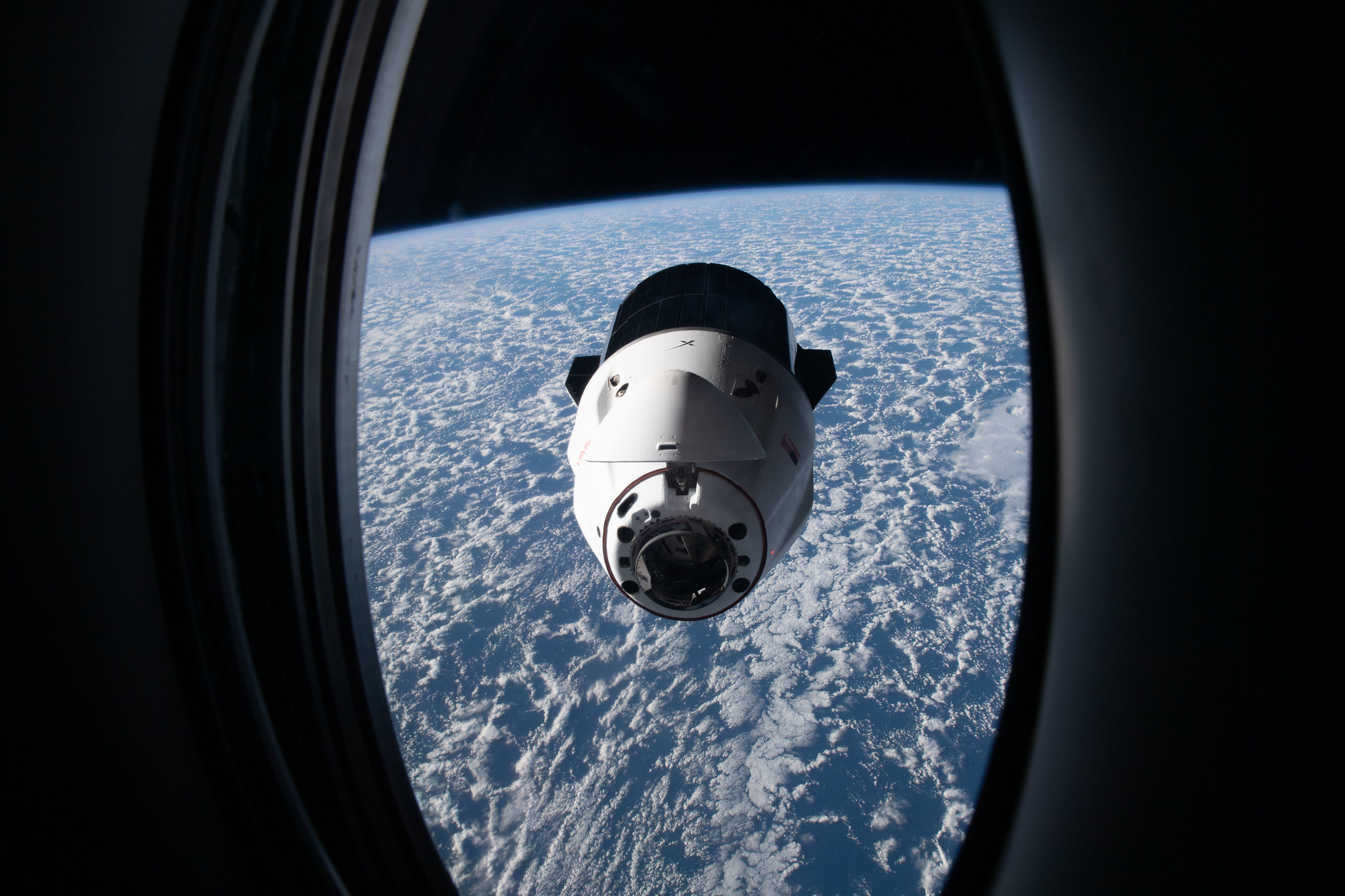
NASA astronauts and Expedition 67 crew members Bob Hines and Jessica Watkins were actively monitoring operations from the cupola workstations on the orbiting research laboratory.
Mission controllers at NASA Johnson in Houston and SpaceX in Hawthorne tracked and worked the rendezvous and docking operation
The SpaceX cargo Dragon was jam packed with some 5800 pounds (2600 kg) of groundbreaking science and critical crew supplies.
The @SpaceX #Dragon docked to the station at 11:21am ET today. The Exp 67 crew will soon open the hatch and begin unloading over 5,800 pounds of new science experiments and crew supplies. https://t.co/Vf1Womiwfk
— International Space Station (@Space_Station) July 16, 2022
Among the unpressurized cargo in the Dragon trunk is the $118 million EMIT dust monitoring experiment which will for the first time determine the composition of the fine dust grains in Earth’s atmosphere and help determine whether they alternatively cool or heat the atmosphere – significantly aiding climate change research.
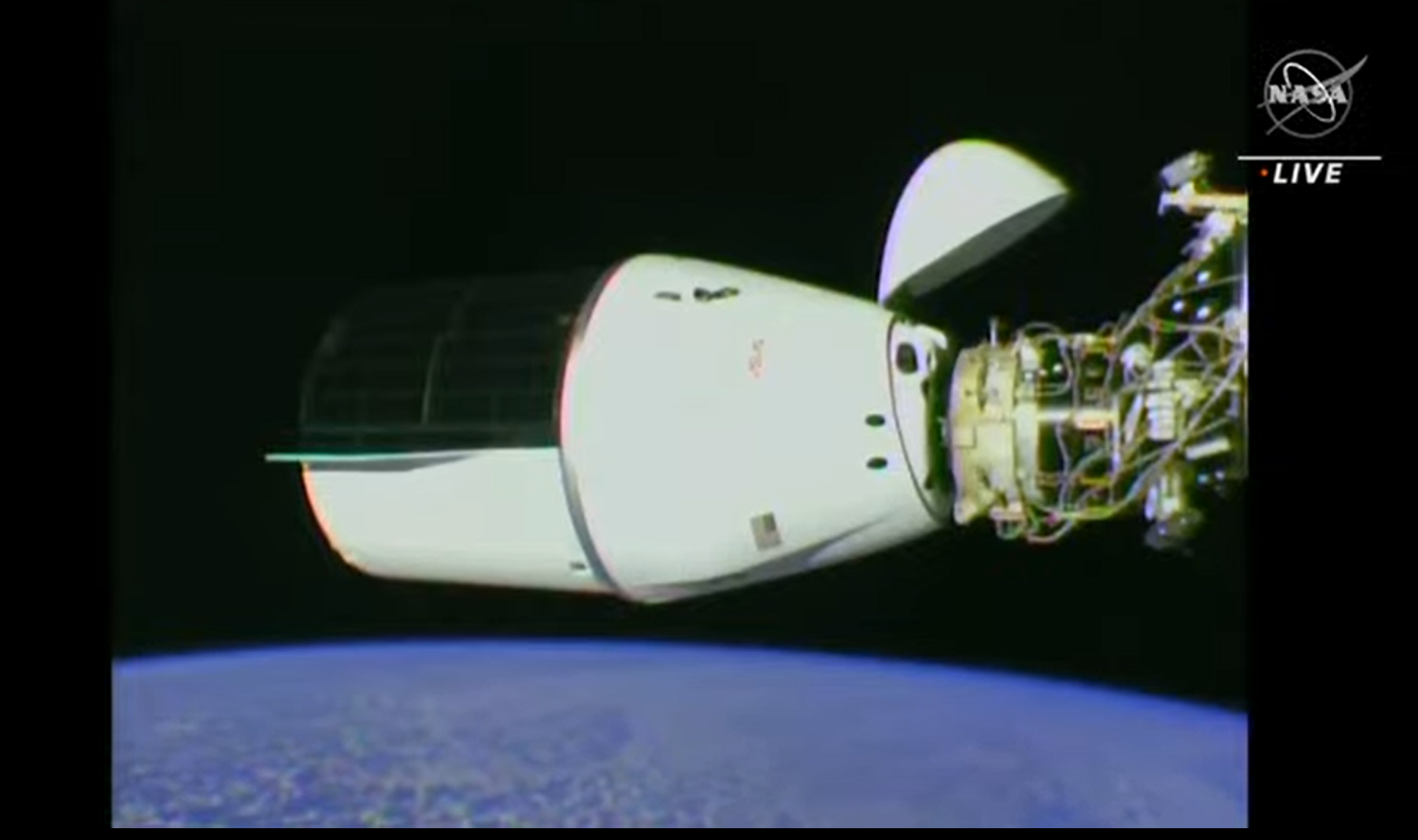
After Dragon spends about one month attached to the space station, the spacecraft will return to Earth with cargo and research.
The NASA SpaceX Falcon 9 and Cargo Dragon lifted off on SpaceX’s 25th NASA contracted Commercial Resupply Services (CRS-25) mission to the International Space Station since 2012 during an instantaneous launch window at 8:44 p.m. EST Thursday, July 14, (0044 GMT, July 15), from historic Launch Complex 39A (LC-39A) at the Kennedy Space Center in Florida.
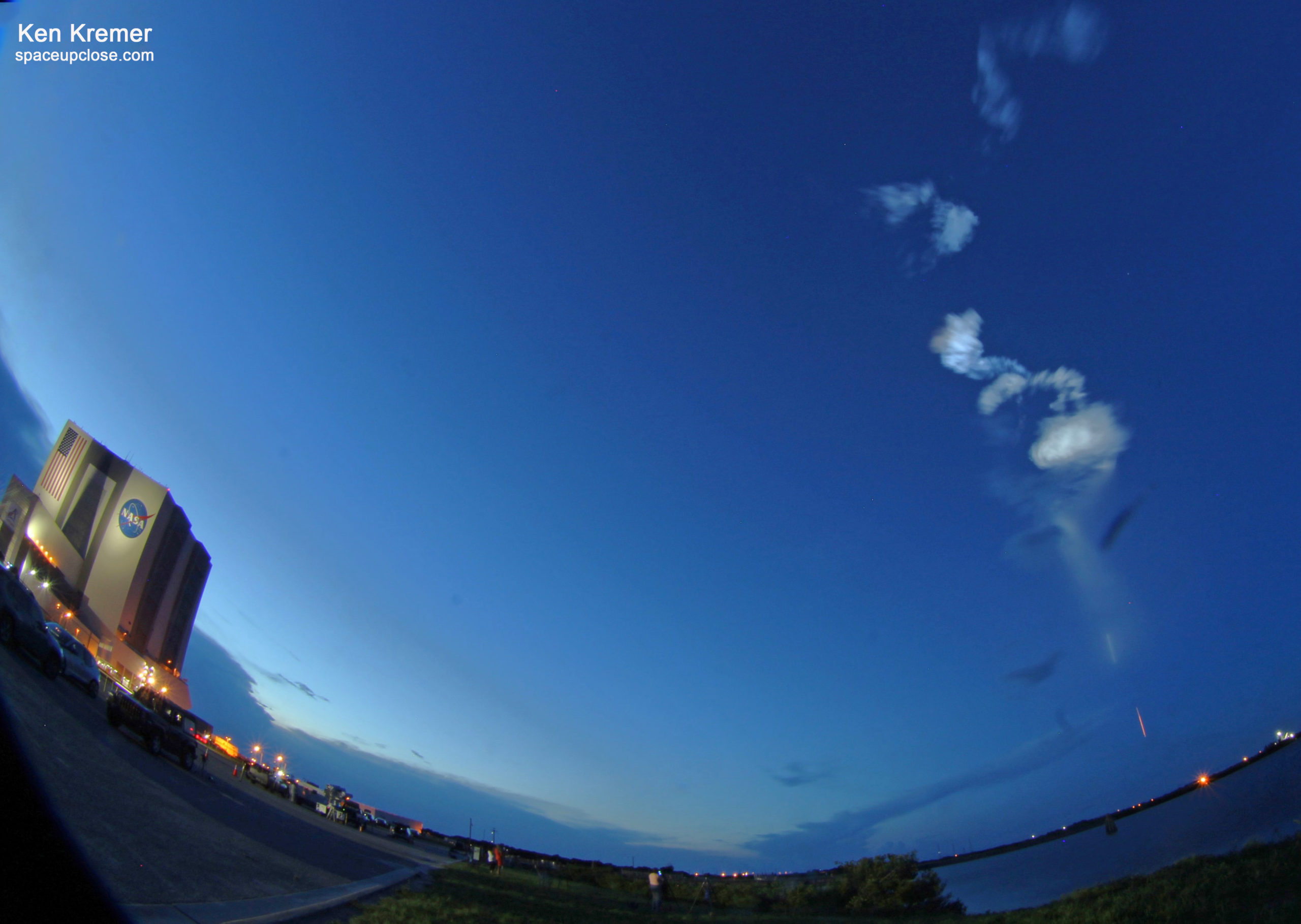
Expected rainstorms and clouds luckily veered away to the north and south of the KSC launch pad – offering a crystal clear and minutes long view of the magnificent ‘Space Jellyfish’ sky show as the Falcon 9 rocket rose from twilight into daylight and formed as the expanding plume of rocket exhaust particles was illuminated by sunlight.
For at least a minute the space jellyfish – also looking like a space nebula – appeared to come to life and swim across the sky – arcing over as the rocket normally does to follow the curvature of the Earth
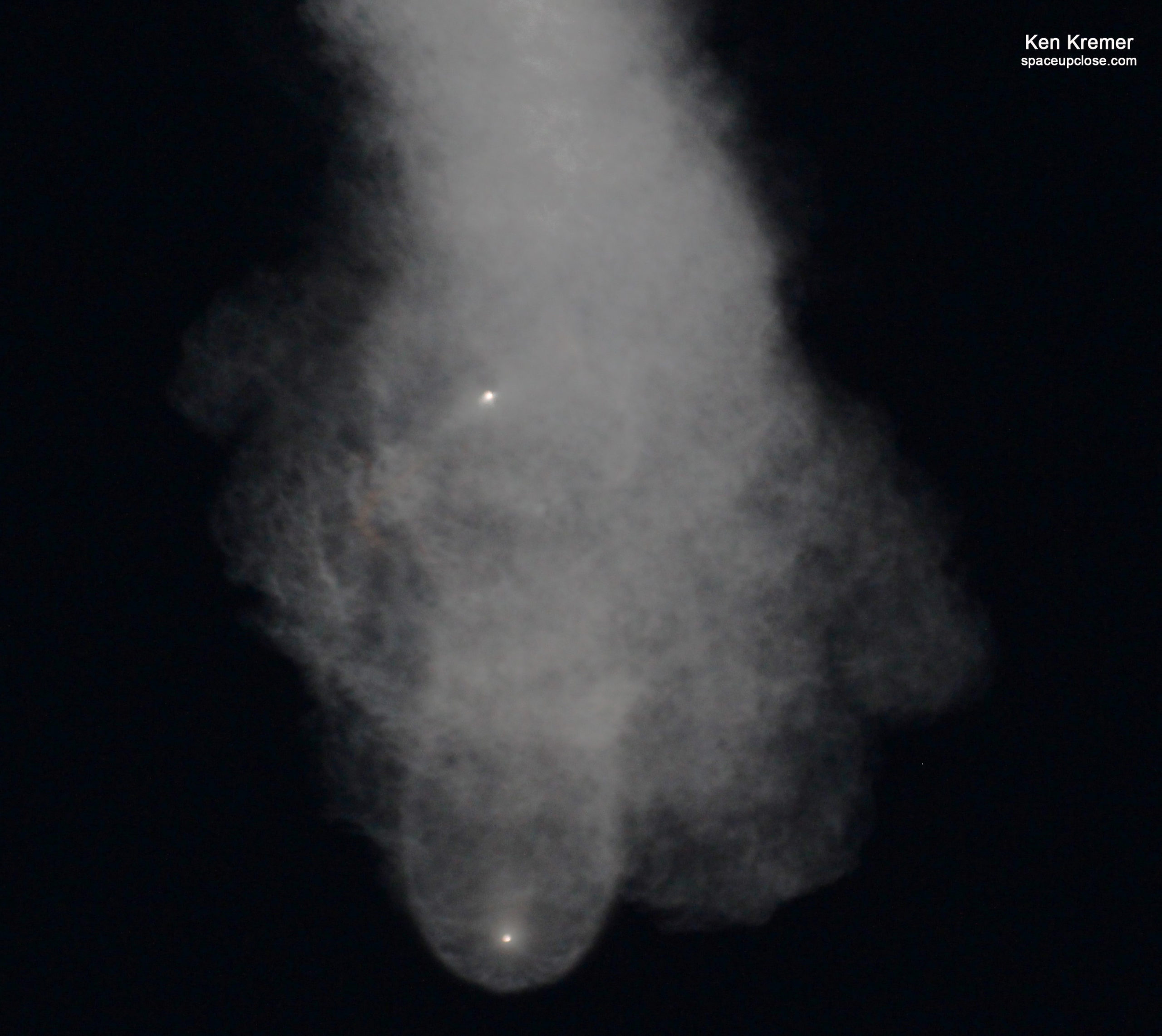
Even the stage separation of the first and second stages was easily visible to the naked eye as a pair of bright lights.
The SpaceX Falcon 9 and Cargo Dragon stack standing 215-feet-tall (65-meters) launched on a northeasterly trajectory along the U.S. East coast at a 51 degree inclination to the equator in line with the orbital plane of the ISS to meet up with it.
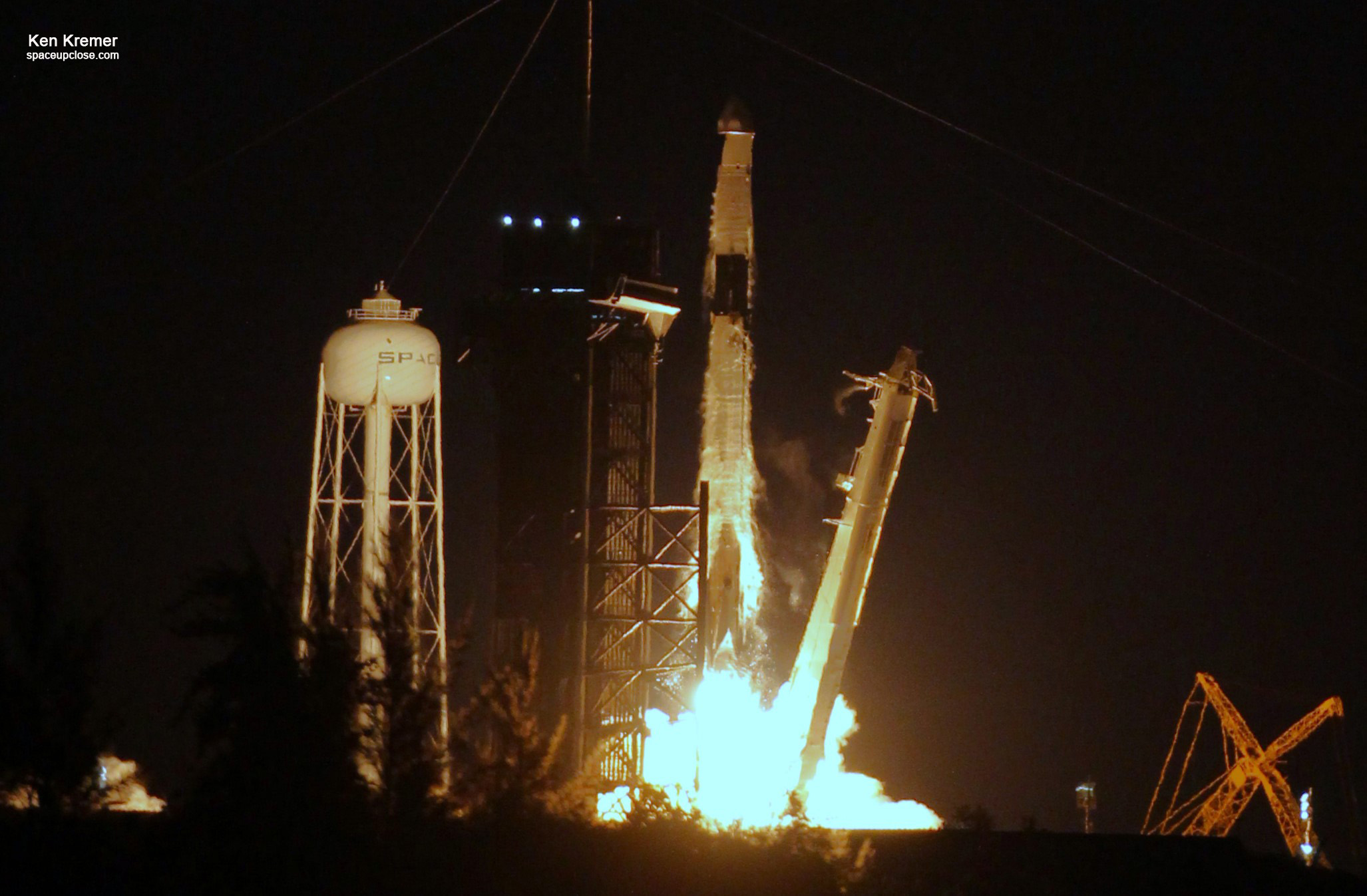
In another remarkable achievement SpaceX landed the spent first stage on the ‘A Shortfall of Gravitas ‘ (ASOG) droneship off the coast of the Carolinas in the Atlantic Ocean.
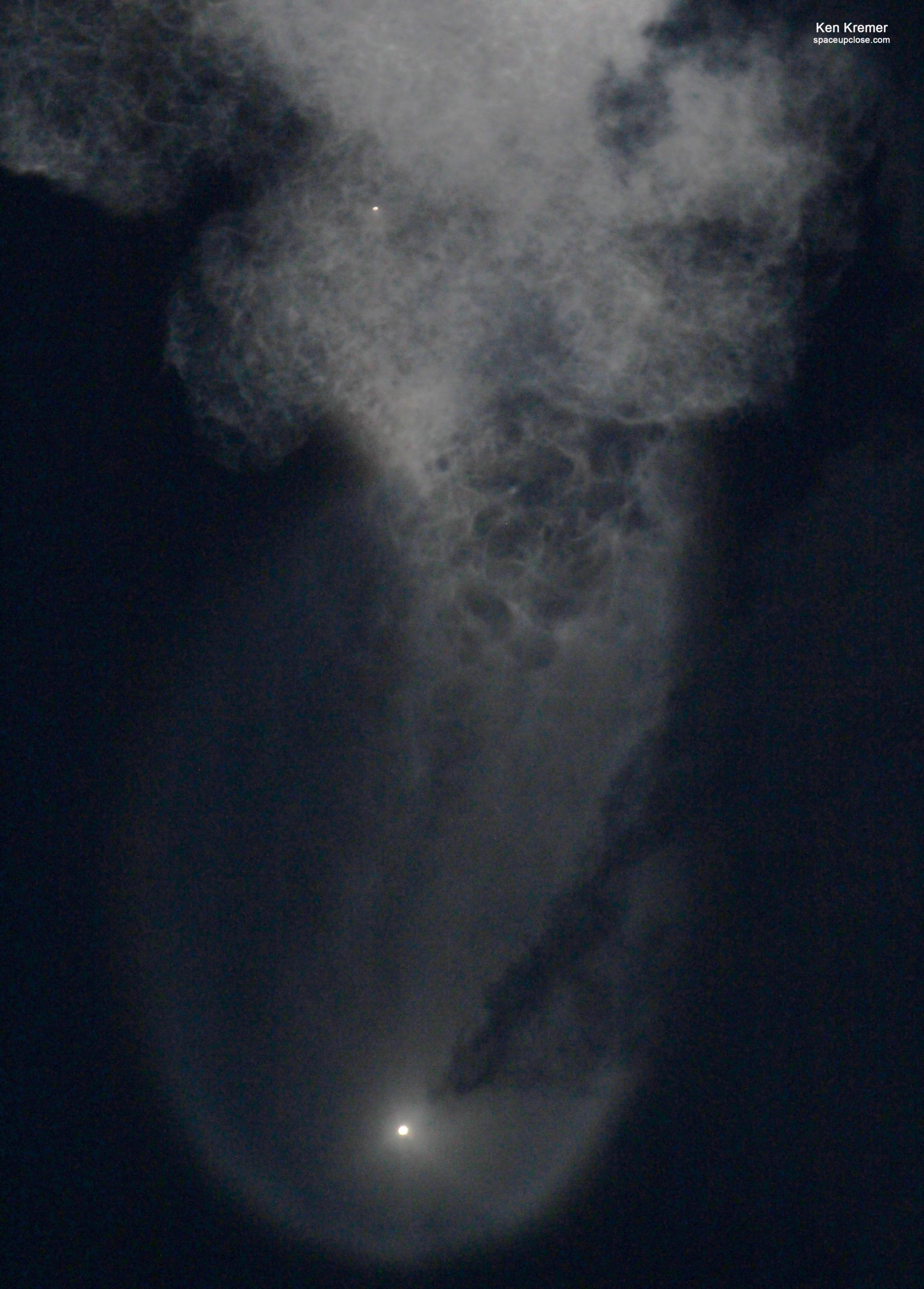
To date SpaceX has launched 164 Falcon 9 rockets since 2010 and it’s the 106th launch of a reused booster
The recycled Cargo Dragon resupply spacecraft launched on its third resupply flight to the ISS.
The SpaceX Dragon CRS-25 resupply craft is loaded with some 5,881 pounds (2,668 kilograms) pounds of science experiments, crew supplies, fresh fruit, food and vegetables, water, clothing, and other cargo for delivery to the seven person crew Expedition 67 crew of astronauts and cosmonauts living and working aboard from NASA, ESA and Roscosmos
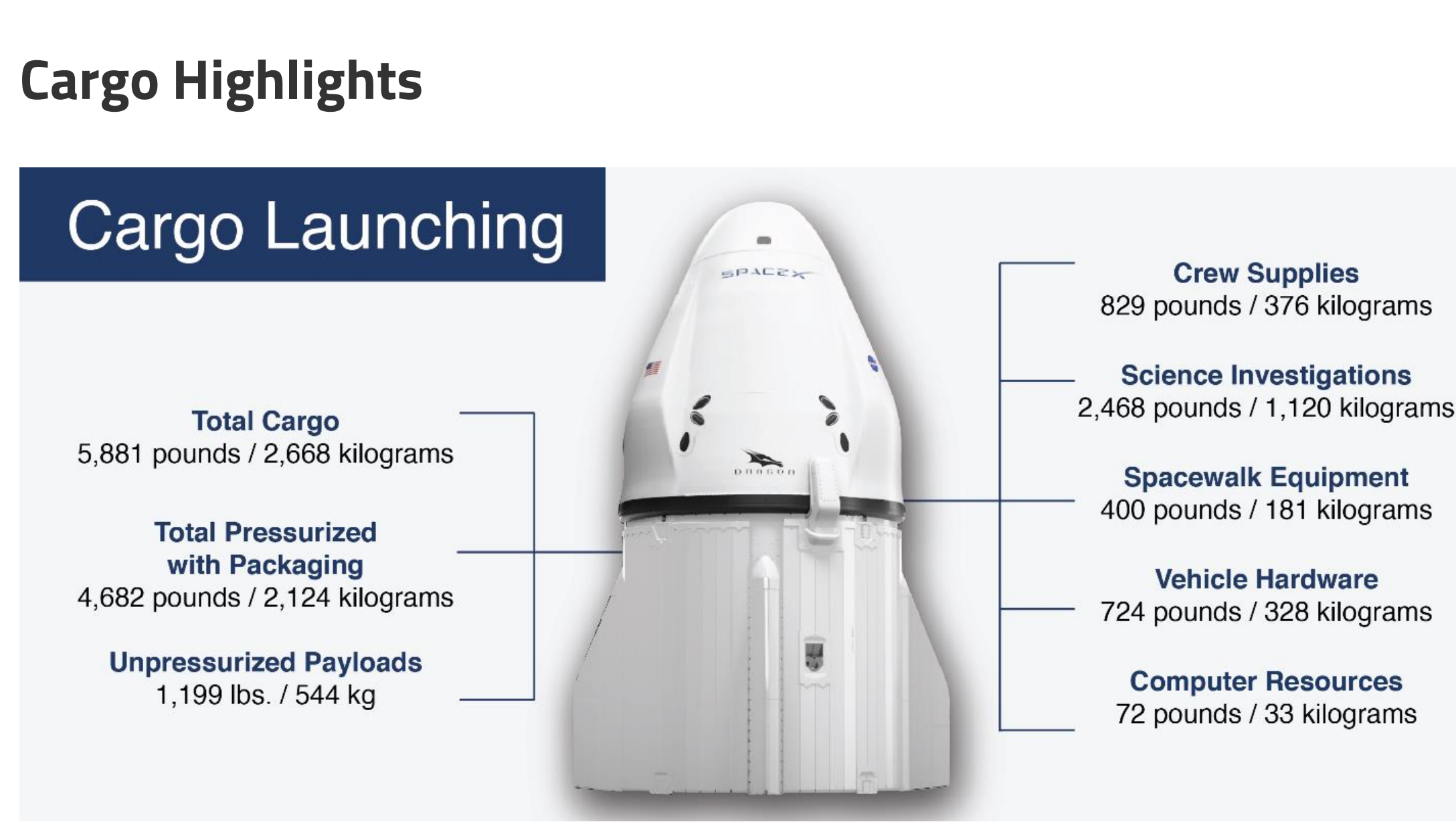
See our launch and prelaunch photos taken by the Space UpClose team of Ken Kremer and Jean Wright.
Here is a NASA description of some of the science experiments Dragon is delivering to the space station:
Mapping Earth’s Dust
The Earth Surface Mineral Dust Source Investigation (EMIT), developed by NASA’s Jet Propulsion Laboratory in Southern California, employs NASA imaging spectroscopy technology to measure the mineral composition of dust in Earth’s arid regions. Mineral dust blown into the air can travel significant distances and affect Earth’s climate, weather, vegetation, and more. For example, dust containing dark minerals that absorb sunlight can warm an area, while light-colored mineral dust can cool it. Blowing dust also affects air quality, surface conditions such as rate of snow melt, and phytoplankton health in the ocean. The investigation collects images for one year to generate maps of the mineral composition in the regions on Earth that produce dust. Such mapping could advance our understanding of the effects of mineral dust on human populations now and in the future.
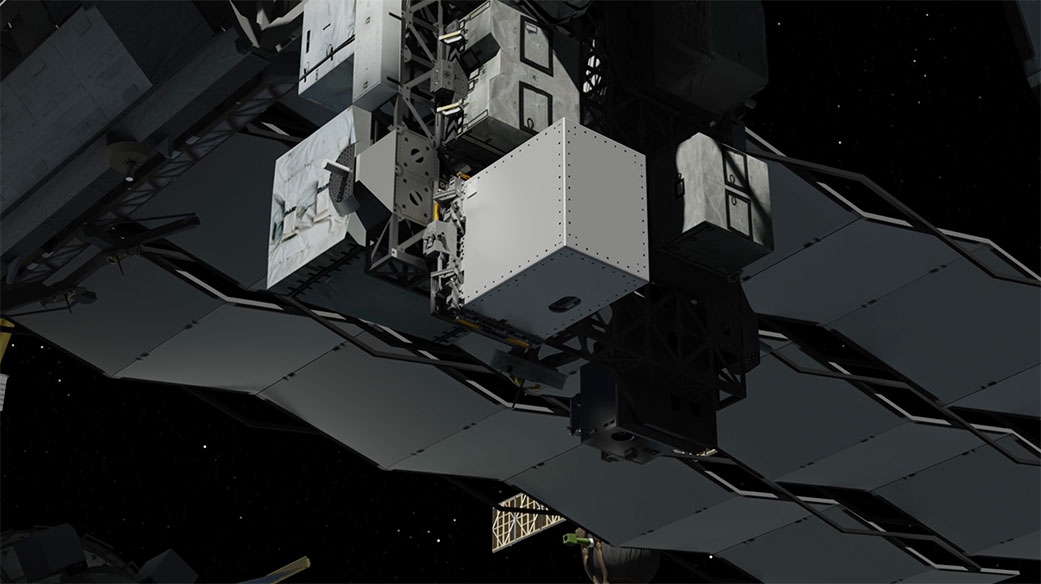
Credits: NASA/JPL-Caltech
Video caption: Using image spectrometer technology developed at JPL, NASA’s EMIT mission will map the surface composition of minerals in Earth’s dust-producing regions, helping climate scientists better understand the impact of airborne dust particles in heating and cooling the planet’s atmosphere. Credits: NASA/JPL-Caltech
Speedier Immune System Aging
Aging is associated with changes in the immune response known as immunosenescence. Microgravity causes changes in human immune cells that resemble this condition, but happen faster than the actual process of aging on Earth. The Immunosenescence investigation, sponsored the by International Space Station U.S. National Laboratory, uses tissue chips to study how microgravity affects immune function during flight and whether immune cells recover post-flight. Tissue chips are small devices that contain human cells in a 3D structure, allowing scientists to test how those cells respond to stresses, drugs, and genetic changes.
Soil in Space
On Earth, complex communities of microorganisms carry out key functions in soil, including cycling of carbon and other nutrients and supporting plant growth. Dynamics of Microbiomes in Space sponsored by NASA’s Division of Biological and Physical Sciences, examines how microgravity affects metabolic interactions in communities of soil microbes. This research focuses on microbe communities that decompose chitin, a natural carbon polymer on Earth.
High School Student Weather Study
BeaverCube is an education mission that will teach high school students aerospace science by having them design a CubeSat. BeaverCube will host one visible and two infrared imagers to measure cloud properties, ocean surface temperatures, and ocean color to study Earth’s climate and weather systems. It also will demonstrate an application for the use of shape memory alloy technology via an in-orbit calibration technique.
Genes, No Cells
Cell-free technology is a platform for producing protein without specialized equipment of living cells that need to be cultured. Genes in Space-9, sponsored by the National Lab, demonstrates cell-free production of protein in microgravity and evaluates two cell-free biosensors that can detect specific target molecules. This technology could provide a simple, portable, and low-cost tool for medical diagnostics, on-demand production of medicine and vaccines, and environmental monitoring on future space missions.
Better Concrete
Biopolymer Research for In-Situ Capabilities looks at how microgravity affects the process of creating a concrete alternative made with an organic material and on-site materials, such as lunar or Martian dust, known as a biopolymer soil composite. Using resources available where construction takes place makes it possible to increase the amount of shielding.
These are just a few of the hundreds of investigations currently being conducted aboard the orbiting laboratory in the areas of biology and biotechnology, physical sciences, and Earth and space science. Advances in these areas will help keep astronauts healthy during long-duration space travel and demonstrate technologies for future human and robotic exploration beyond low-Earth orbit to the Moon and Mars through NASA’s Artemis program.
…

SpaceX is under contract with NASA for another 10 resupply missions in the future through CRS-35 after six more were recently added
Watch Ken’s commentary about NASA SpaceX Cargo Dragon, JWST, Project Artemis, Capstone, NASA SLS WDR demo test, SpaceX missions including NASA Crew-3 and Crew 4, AX-1, Nilesat 301, Transporter-5, Starlink, Boeing Starliner, and NASA TROPICS 1.
Jul 14: Watch Ken’s live interview on NewsNation interview about the CRS-25 launch & dangers from falling rockets and space debris collisions
Jul 14: WFTV ABC Orlando News featured my commentary about the CRS-25 mission
Jul 12: Watch Ken’s live interview on NewsNation interview about the release of the stunning first science images taken by NASA Webb and the spectacular discoveries about star birth, star death, galactic evolution, exoplanet atmospheres and much more and what it means.
Watch Ken’s BBC World TV interview about Webb achieving final orbit and the goals ahead on Jan 24, 2022.
Video Caption: Dr. Ken Kremer of Space UpClose live interview on BBC World News TV on Jan. 24, 2022 ET (Jan. 25 GMT) about NASA James Webb Space Telescope (JWST) just hours after achieving orbit at its final destination, why at L2, what’s ahead with spacecraft checkouts, what are the science goals and when are first pictures expected
Jul 6/7: Fox 35 Orlando featured my commentary about NASA Capstone cubesat mission – communications just reestablished after 2 day loss. Capstone is a pathfinder mission for NASA’s Gateway mini lunar space station. Now preparing for 1st trajectory correction maneuver (TCM) and heading to lunar orbit
Jul 5/6: WKMG CBS 6 Orlando News featured my commentary about todays loss of contact with NASA’s CAPSTONE lunar cubesat mission. CAPSTONE had been healthy until a 2nd comm pass. Team is attempting to reestablish contact. Goal: test the stability of the unique orbit planned for NASA Gateway mini human space station:
Jul 5/6: WFTV ABC Orlando News featured my commentary about today’s loss of contact with NASA Capstone cubesat mission which is a pathfinder test for the Gateway mini human lunar space station
Jun 21/22: WFTV ABC Orlando News featured my commentary about NASA’s 4th SLS WDR fueling attempt Jun 20, the results and whats ahead after NASA conducts detailed analysis of the 1st tanking test to completely load both stages with LOX & LH2 and run the terminal count to T-29 sec despite a hydrogen leak – achieving many but not all objectives
Jun 17: Fox 35 Orlando featured my commentary about the selection of 2 NASA astronauts to fly on the 1st crewed mission of Boeing Starliner capsule on CFT test flight late 2022 – and what it means for human spaceflight to have a 2nd US commercial crew provider following the successful Boeing Starliner OFT-2 mission for NASA
Jun 9/10: WFTV ABC Orlando features my commentary about the upcoming NASA TROPICS 1 & 2 cubesat science launch on an Astra Rocket 3.3 from pad 46 for NASA which will study the formation and evolution of Tropical Cyclones and Hurricanes. Two more launches will follow for 6 TROPICS cubesats altogether over next few months
Jun 8: WFTV ABC Orlando features my commentary about the SpaceX Falcon 9 launch of NileSat301 telecom sat for Egypt
June 6/7: WFTV ABC Orlando features my commentary about completing 2nd rollout to pad 39B for 2nd round WDR tanking test, what’s involved in and why its critical to the future of Project Artemis:
Watch Ken’s continuing reports about SpaceX missions Artemis, SLS, Orion and NASA missions, SpaceX Crew and Cargo Dragons, SpaceX Axiom-1, JWST, IXPE, DART, Lucy Asteroid mission, GOES, SpaceX Starlink, Commercial Crew and Starliner and Crew Dragon, Blue Origin and Space Tourism, and onsite for live reporting of upcoming and recent SpaceX and ULA launches including Crew 1 & 2 & 3 & 4, ISS, Solar Orbiter, Mars 2020 Perseverance and Curiosity rovers, NRO spysats and national security missions and more at the Kennedy Space Center and Cape Canaveral Space Force Station.
Stay tuned here for Ken’s continuing Earth and Planetary science and human spaceflight news: www.kenkremer.com –www.spaceupclose.com – twitter @ken_kremer – email: ken at kenkremer.com
Dr. Kremer is a research scientist and journalist based in the KSC area, active in outreach and interviewed regularly on TV and radio about space topics.
………….
Ken’s photos are for sale and he is available for lectures and outreach events
Please consider supporting Ken’s work by purchasing his photos and/or donating at Patreon
https://www.patreon.com/kenkremer
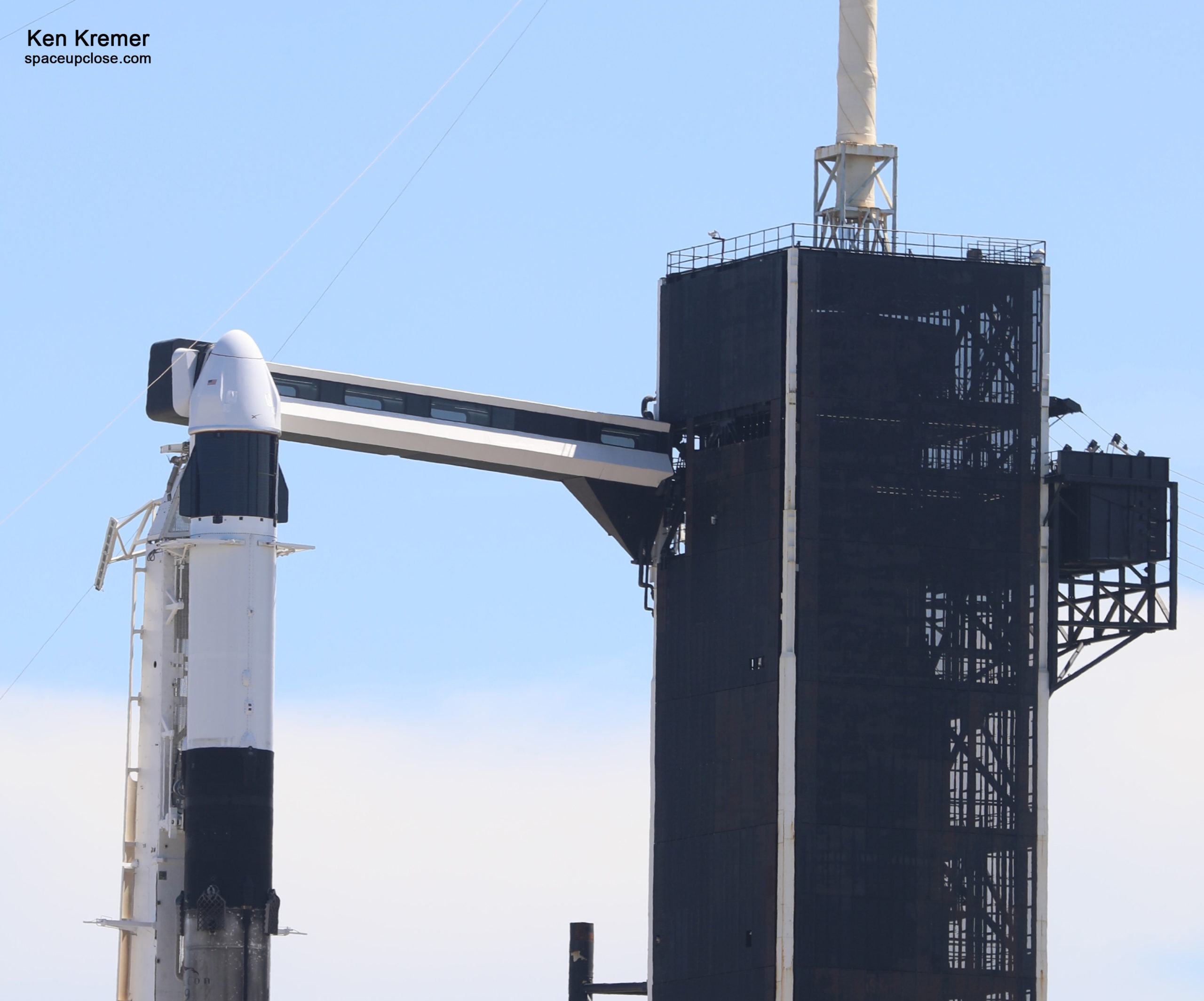
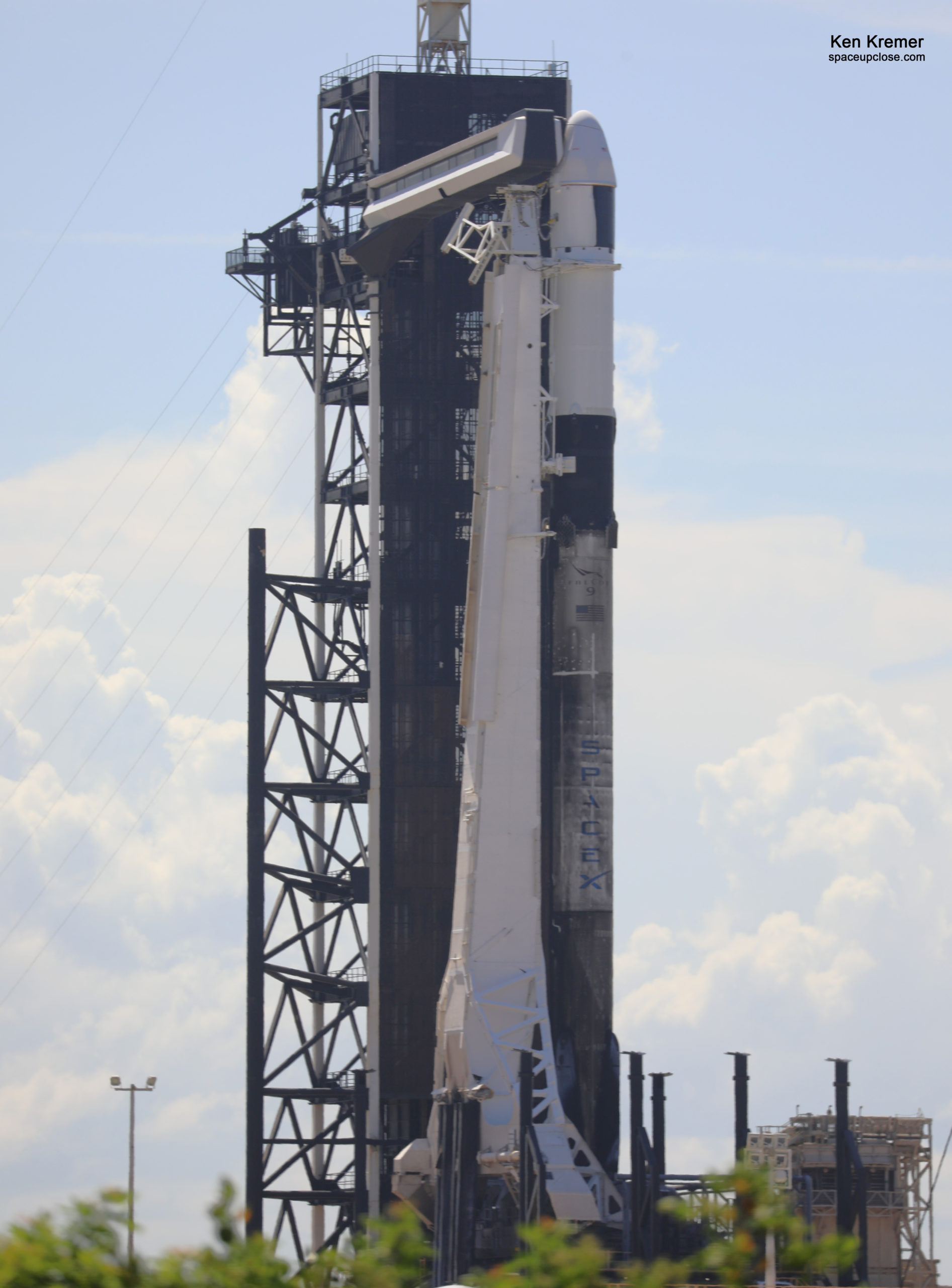
x
x



